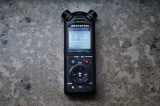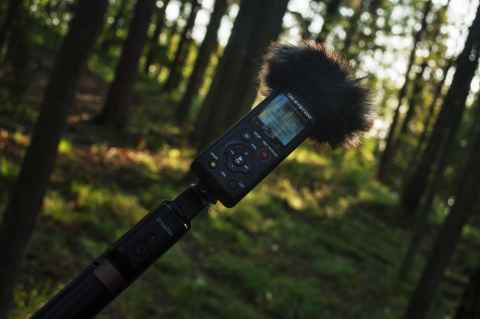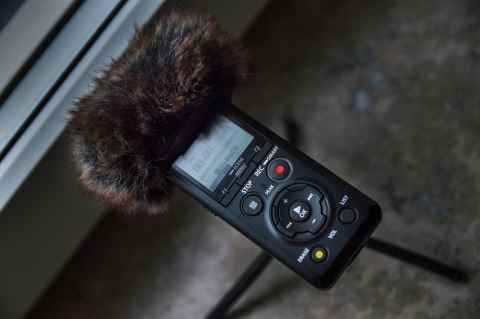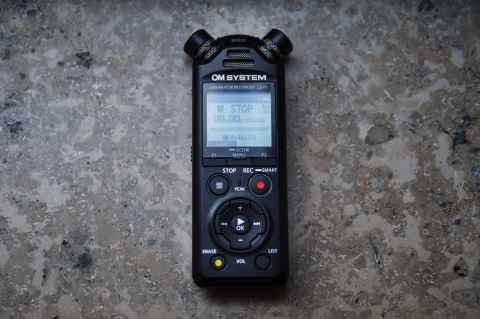Good video is one thing, but if you really want immersion you need good sound. The LS-P5 from OM System (previously Olympus) is a small recorder with good quality sound, in a small package, for a nice price.

OM System LS-P5
Handheld Linear PCM Recorder
- Recording modes
- Formats
- WAV, FLAC, MP3
- Sample rates
- 96 kHz, 88.2 kHz, 48 kHz, 44.1 kHz
- Bit depths
- 24 bit, 16 bit
- Bit rates
- 320 kpbs, 128 kbps, 64 kbps (mono)
- USB
- Modes
- Storage or storage and audio input / output
- Speed
- USB 2 High Speed
- Microphone System
- Model
- Tresmic II, three directional microphones
- Max sound pressure
- 125 dB SPL (1% dist.)
- Signal-to-noise ratio
- 60 dB (center), 57 dB (sides)
- Pros
- Good sound quality
- Very portable - a lot of power in a small package
- Nice price
- Cons
- No USB 3.0, transferring files to the PC is slow.
- No 32 bit recording.
- No button or option to set the volume to mic level.
A small recorder with good quality sound, in a small package, for a nice price. (5/5)
1. Body and Handling
One thing I noticed immediately when switching from my Zoom H2 was just how small the LS-P5 was. The H2 is pocketable if you have big pockets, but the LS-P5 can easily be dropped into any pocket. Operation is quick and easy, and the 1/4 inch socket makes it easy to mount on a camera. For me, this is perfect. I'm not interested in a field recording rig. I want something that I can take places easily and often. When you live in a city the main challenge is environmental noise, and having super-sensitive microphones will just pick up more of it. The only way to reduce noise is to escape it, and in order to escape it I need something I can carry.
The LS-P5 excels at this. It can be hand-held, or mounted on a miniature tripod and / or controlled via Bluetooth using the DVR.Remote[a] app.
The LS-P5 is a bit behind the times in other ways though: there is no support for 32-bit float recording[b], and no USB 3.0. But these are minor annoyances. For my uses (field recording), setting the recording level is fine, and if it takes a little bit longer to transfer the recordings to my PC it's not a big deal. Still, technology improves by ridding us of one annoyance at a time, and having to set levels and wait for file transfers are two I thought we were done with.
1.1. Connecting to a Camera
The LS-P5 can be used as a separate recorder as well as an external microphone. For this you may want to consider a shock mount, like the Movo SMM5-B[c] to minimize handling noise from the camera. The OM System tutorial[d] skips over a few things, though. First, to actually get any sound going from the LS-P5 to your camera, you need to press the recording button. Second, since you are sending the headphone output from the LS-P5 to the microphone in connection on the camera, you need to set the microphone recording level on the camera and the headphone volume on the LS-P5. For this I recorded a test tone and then just clicked around until the VU meters on the camera and the LS-P5 looked about the same, and found that setting microphone sensitivity to 15 or auto on a Nikon D3200 and a Nikon D600 corresponded to a headphone volume of 03. Sensitivity 10 had a matching headphone volume of 07. Your mileage may vary, so do run a sound check on your own camera, and I'd treat the camera recording as a backup the way the tutorial recommends. For a recorder that is intended for and marketed for use as an external microphone, it's an omission that there isn't a button to automatically set the headphone output level to mic level; especially as too high an output can actually damage the camera.
2. Sound Quality
The recorder supports up to 24 bit / 96 kHz recording. While 32-bit recording would be nice, it hasn't mattered much in practice for me. The signal-to-noise ratio is acceptable for enthusiast use: 92 dB on the line-in connector, 60 dB on the middle microphone and 57 dB on the stereo microphones. It can record up to 125 dB SPL, so it works even at loud concerts. I haven't been able to find any authoritative sources regarding the equivalent input noise, but the AVISoft Recorder tests[e] list its predecessor LS-P4 as being -114 dBu for A-weighted and -111 dBu unweighted 20 Hz to 20 kHz, which hints at the capabilities of this unit.
My experience is that the input noise, as well as the sound quality, is handled well enough. The major problem is getting to a good, noise-free, place to do the recording, and when there, to position the recorder appropriately, taking care to manage wind and other environmental noise sources. In short, I have skill issues, not equipment issues.
3. Samples
4. Measurements
One thing I've noticed when searching the web for information about a source recorder to buy is the near-total absence of standardized measurements relating to sound quality. If the photography web has an over-belief in MTF charts and numbers that may or may not apply to real-world conditions, the field recording web is mostly subjective statements that may or may not mean anything since there is no fixed reference. Whether you think comparing two lenses with corner MTF at 30 lp/mm is 0.95284
versus corner MTF at 30 lp/mm is 0.94012
is more valuable than comparing two recorders using unparalleled depth and warmth but with some harshness in the complexity
versus great depth and warmth but a slight coldness when recording complex sounds
is a matter of taste, but at least with the numbers I can tell when someone is full of it - with the subjective statements I am forced to assume that.
4.1. Recording Levels
With digital cameras you can control the amount of gain using the ISO setting, and basically higher ISO means brighter image. However, you also amplify the noise to a varying degree, with lower ISO gains amplifying the noise a little, and higher ISO values more. In almost all modern cameras there is a point at which your camera turns "ISO-less" - when increasing the gain amplifies the noise as much as it amplifies the image. At this point, you are better off brightening the image in post-processing.
For the LS-P5 I wanted to know what the signal to noise ratio was as I turned up the recording level. If I wanted to record a faint sound outdoors, would I be better off keeping the rec level low and turning the volume up in post, or should I crank the rec level up as far as it would go? Or something in-between?
This is not a pro-level experiment. I recorded silence by wrapping the recorder in a blanket and putting it in the quietest room in the apartment. It was far from silent - I could see my steps on the VU meter when I walked away from the bundle - but just like measuring the sharpness of a camera and lens combo it gets you a rough idea of how things work. I then compared the silence with a recording of a 440 Hz tone obtained by shoving the LS-P5 into a set of headphones, by using Audacity[f] to measure the RMS dBFS for the recordings. Note that this is not a measurement of the noise floor or dynamic range of the recorder - it is strictly a test of how the recorder behaves as the recording level is changed. These measurements are only valid when compared to each other.
| Rec Level | Silence | Tone | Signal-to-Noise |
|---|---|---|---|
| 5 | -92.5767 | -59.5921 | 32.9846 |
| 10 | -91.2119 | -51.7455 | 39.4664 |
| 20 | -77.5168 | -36.5132 | 41.0036 |
| 30 | -62.6791 | -21.1378 | 41.5413 |
| 40 | -49.0709 | -12.0609 | 37.01 |
I interpret the above as the recording quality being pretty much flat as long as you get it above the noise floor, and that over rec level 30 there's an amplification that actually reduces the SNR.
4.2. Pickup Pattern
The Tresmic II microphone system has a directional zoom feature that lets you change the width of the field in 21 steps, with zero being the widest and 20 being the narrowest. This is done by mixing the signal from the center capsule with the signals from the two side capsules. Since I couldn't find any actual measurements of the pattern I did a quick test on my desk with a 440 Hz test tone. Again, this is a quick test to get an idea of what is going on, not a professional in-depth look at the characteristics of the Tresmic II system.
| Zoom 0 | Zoom 10 | Zoom 20 | |
|---|---|---|---|
| 0 | 0.029204 | 0.033798 | 0.041759 |
| 22.5 | 0.029143 | 0.029597 | 0.036255 |
| 45 | 0.028448 | 0.024317 | 0.028408 |
| 67.5 | 0.024912 | 0.020695 | 0.021283 |
| 90 | 0.020877 | 0.013964 | 0.014557 |
| 112.5 | 0.014446 | 0.008163 | 0.007750 |
| 135 | 0.011569 | 0.006952 | 0.008138 |
| 157.5 | 0.008290 | 0.007293 | 0.010742 |
| 180 | 0.008034 | 0.007684 | 0.011870 |
| Silence | 0.000922 | 0.000844 | 0.000876 |
5. Summary
Pros
Good sound quality
Very portable - a lot of power in a small package
Nice price
Cons
No USB 3.0, transferring files to the PC is slow.
No 32 bit recording.
No button or option to set the volume to mic level.







